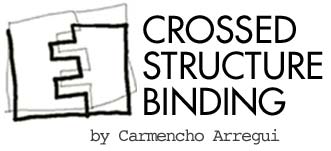

The Origin
When I have to explain the origin of the Crossed Structure Binding in one of my workshops I show a long-stitch binding and say that I had seen this type of binding many times in my restoration work and found the idea of sewing the book directly to the cover a very good one, but at the same time, I wanted to have access to the spine to reinforce it if necessary.
This is a good, logical explanation for students, but the truth is that I do not know how the idea of the crossing came to my mind and why it was followed by a series of different versions that have no obvious link to traditional bookbinding techniques. What I can say is that I am attracted by good functioning in general, not only in books, and I do my best to attain it. That is why each variation of the CSB tries to give an answer to one specific problem.
I suppose it is not by chance that the back of the book is called the 'spine' and in French, the book block is called le corps d'ouvrage ('the body of the work'). Several generations of books reflect the constrictions of the human mind and body in rigid mental habits and restrictive clothes (habits in French). Possibly, all these centuries of discomfort, that I could almost feel physically, were the starting point of my work.
The word 'structure' applied to the construction of a book is a very recent concept. For centuries the construction of books had been more or less the same and the history of bookbinding was the history of bookbinding's decor. The French designer Legrain wrote these words at the beginning of the twentieth century: "One has to consider the purely technical question of a discipline, which has reached perfection through the slow accumulation of small improvements, to such an extent that no other time has been better than our time for the making of a binding, the construction of which has not changed and cannot change".
His contention that bindings had reached the high point of perfection and that any further development was not conceivable, has been disproved by all that has followed. He could not have known that in the years to come the traditional 'French binding' was going to be a matter of choice. Not THE binding but one of the alternatives that the new bookbinder could choose to suit his or her needs.
In Florence, after the flood of 1966, many book conservators rediscovered the qualities of medieval bindings and that of lightweight vellum bindings. They started to see books as readable objects that should be free to move without restraint. They probably were the first to talk in terms of 'structure' in referring to books, and to examine how far any structure was sympathetic and appropriate to the needs of the book.
This new way of seeing things awakened a worldwide interest in non-intrusive and non-adhesive book structures.